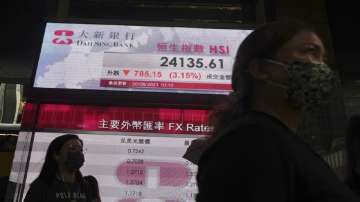Stocks slumped on Wall Street Monday, mirroring losses overseas and putting the S&P 500 index on track for its biggest drop since February.
Worries about debt-engorged Chinese property developers — and the damage they could do to investors worldwide if they default — are rippling across markets. Investors are also concerned that the U.S. Federal Reserve could signal this week that it’s planning to pull back some of the support measures it’s been giving markets and the economy.
The S&P 500 fell 2.2% as of 1:21 p.m. Eastern. The benchmark index is also coming off two weeks of losses and is on track for its first monthly decline since January.
The Dow Jones Industrial Average fell 799 points, or 2.3%, to 33,783 and the Nasdaq fell 2.7%. Smaller company stocks were among the biggest losers. The Russell 2000 fell 3.2%.
Technology companies led the broader market lower. Apple fell 2.7% and chipmaker Nvidia shed 4.6%.
Banks posted big losses as bond yields slipped. That hurts their ability to charge more lucrative interest rates on loans. The yield on the 10-year Treasury fell to 1.32% from 1.37% late Friday. Bank of America fell 3.1%.
Oil prices fell 2% and weighed down energy stocks. Utilities and other sectors that are considered less risky held up better than the rest of the market.
There were few bright spots. Pfizer held its ground amid the broad market decline after announcing that its vaccine works for children ages 5 to 11 and that it will seek U.S. authorization for that age group soon.
The worries over Chinese property developers and debt recently centered on Evergrande, one of China’s biggest real estate developers, which looks like it may be unable to repay its debts.
Many analysts say they expect China’s government to prevent a blowup serious enough to cause losses to cascade through markets. But any hint of uncertainty may be enough to upset Wall Street, after the S&P 500 has glided higher in almost uninterrupted fashion since October. It set its most recent closing high just over two weeks ago, on September 2.
The Hang Seng, Hong Kong’s main index, dropped 3.3% for its biggest loss since July. Many other markets in Asia were closed for holidays. European markets fell about 2%.
“What’s happened here is that the list of risks has finally become to big to ignore,” said Michael Arone, chief investment strategist at State Street Global Advisors. “There’s just a lot of uncertainty at a seasonally challenging time for markets.”
Besides Evergrande, several other worries have been lurking underneath the stock market’s mostly calm surface. In addition to the Fed possibly announcing that it’s letting off the accelerator on its support for the economy, Congress may opt for a destructive game of chicken before allowing the U.S. Treasury to borrow more money and the COVID-19 pandemic continues to weigh on the global economy.
Regardless of what the biggest cause for Monday’s market swoon was, some analysts said such a decline was due. The S&P 500 hasn’t had even a 5% drop from a peak since October, and the nearly unstoppable rise has left stocks looking more expensive and with less room for error.
ALSO READ | Retail inflation for farm, rural workers eases marginally in August
All the concerns have pushed some on Wall Street to predict upcoming drops for stocks. Morgan Stanley strategists said Monday that conditions may be ripening to cause a fall of 20% or more for the S&P 500. They pointed to weakening confidence among shoppers, the potential for higher taxes plus inflation to eat into corporate profits and other signs that the economy’s growth may slow sharply.
Even if the economy can avoid that worse-than-expected slowdown, Morgan Stanley’s Michael Wilson said stocks could nevertheless drop about 10% as the Fed pares back on its support for markets. The Fed is due to deliver its latest economic and interest rate policy update on Wednesday.
Earlier this month, Stifel strategist Barry Bannister said he expects a drop of 10% to 15% for the S&P 500 in the final three months of the year. He cited the Fed’s tapering of its support, among other factors. So did Bank of America strategist Savita Subramanian, as she set a target of 4,250 for the S&P 500 by the end of the year. That would be a 4.1% drop from Friday’s close.
Investors will have a chance for a closer look at how the slowdown affected a wide range of companies when the next round of corporate earnings begins in October. Solid earnings have been a key driver for stocks, but supply chain disruptions, higher costs and other factors could make it more of a struggle for companies to meet high expectations.
“The market’s biggest strength this year could become its biggest risk,” Arone said.
ALSO READ | Criticism should not be at cost of destroying confidence of nation: Adani on India's Covid handling
Latest Business News
